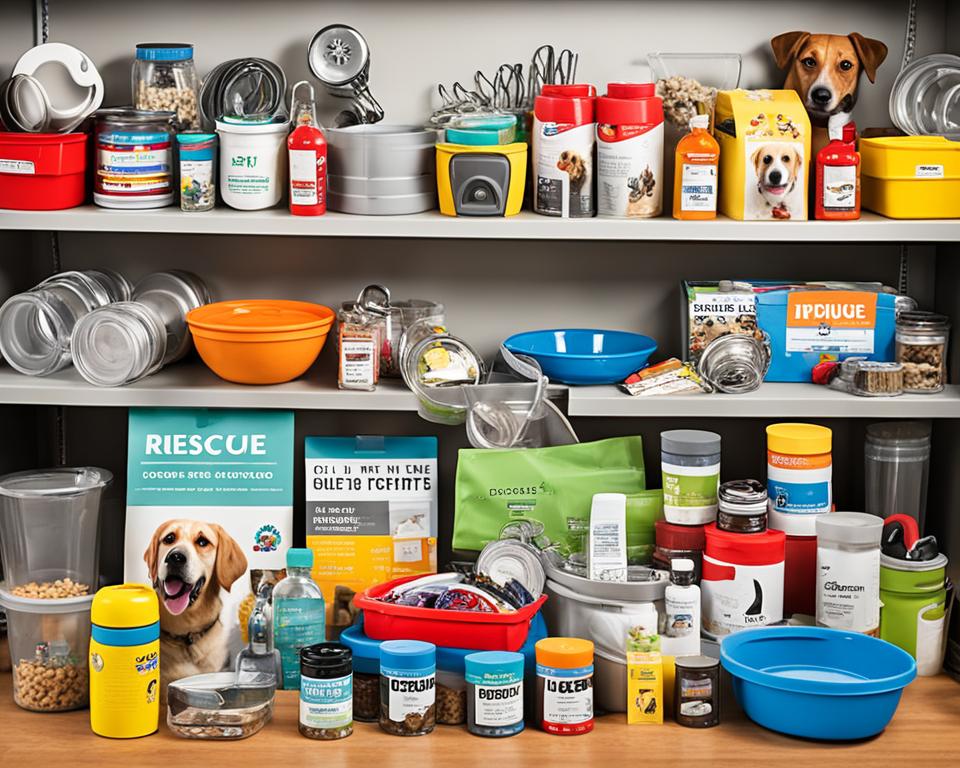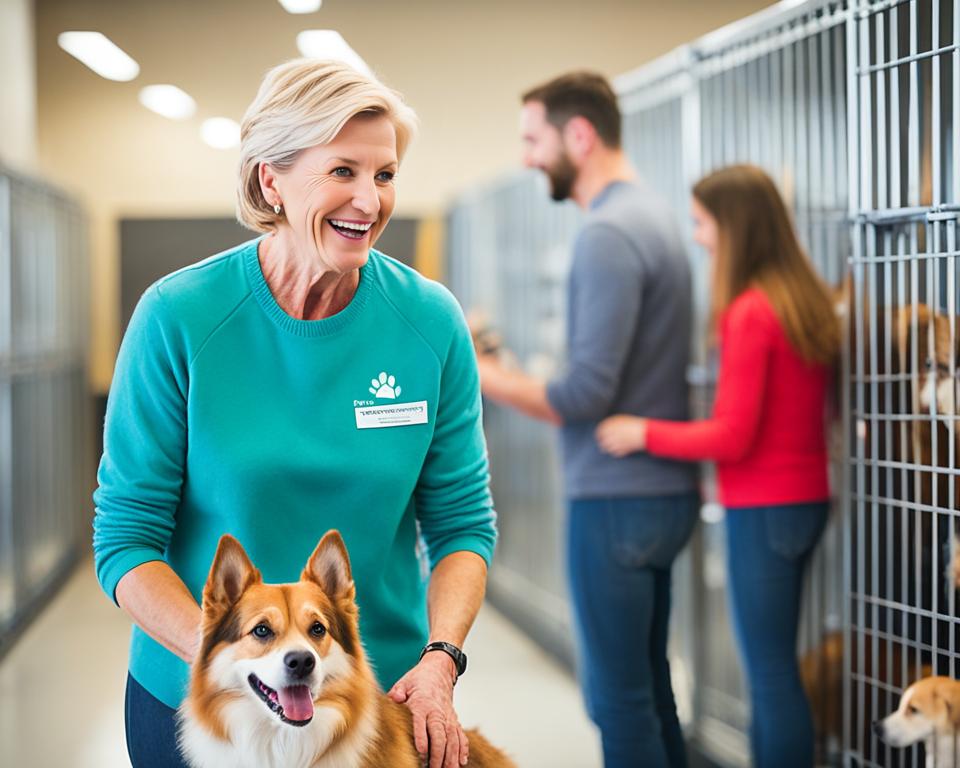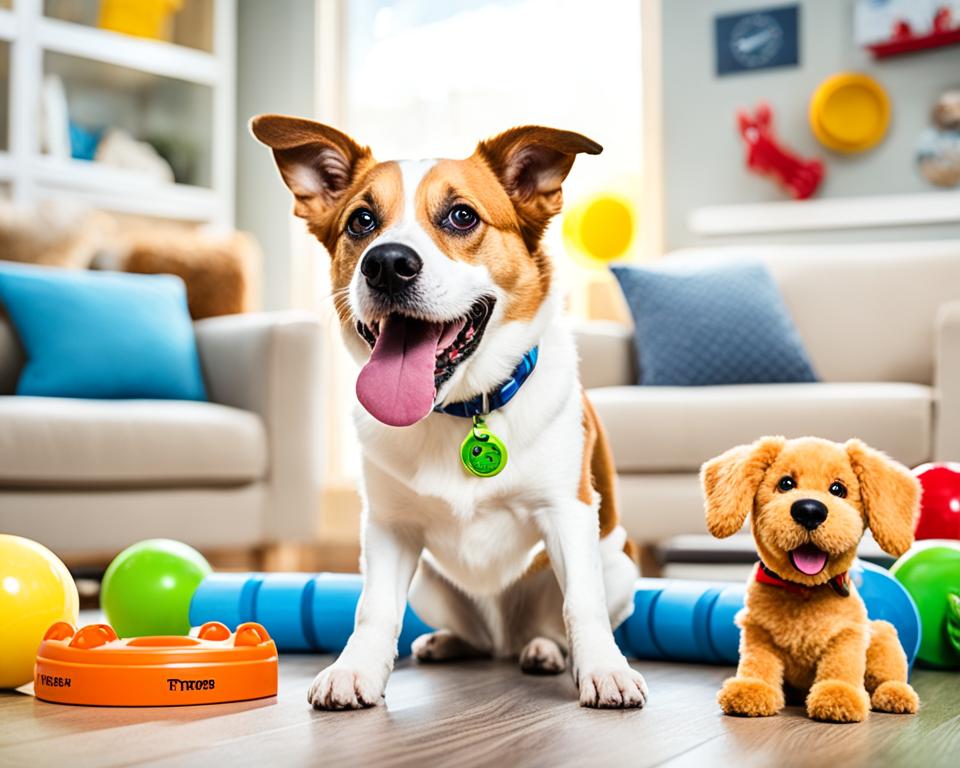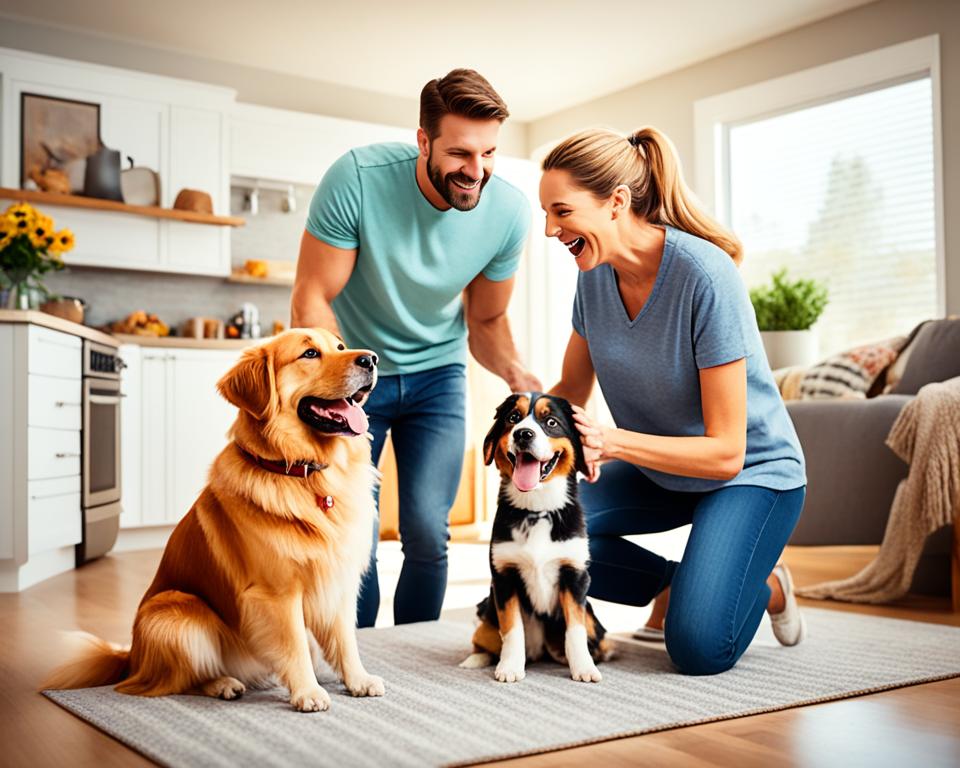I’m excited to share my knowledge on dog adoption with you. Getting a furry friend is a big step. I’ll help you through the process, from rescue to shelter visits.
Dog adoption is a great way to give a loving home to a pet in need. Many shelters are full of dogs waiting for homes. The adoption fee is usually $50 to $300, helping cover shelter costs.
By adopting, you save a life. Shelters often spay or neuter dogs before adoption and may include vaccines. This can save you hundreds in vet bills.
Remember, adopting a dog is a big commitment. Think about your lifestyle, living space, and time for your new pet. But don’t worry, I’ll guide you through it all.
Understanding the Joys and Responsibilities of Dog Adoption
Adopting a dog brings joy and companionship. But, it’s key to know the responsibilities of pet parenting. I’ve learned the benefits of giving shelter dogs forever homes.
The Benefits of Adopting from a Shelter
Adopting from a shelter saves lives and fights dog overpopulation. Millions of dogs face euthanasia yearly due to shelters being too full. By adopting, you gain a loyal friend and support ethical practices.
Many pet shop puppies come from cruel places. Shelter dogs get proper care and health checks.
Assessing Your Lifestyle and Compatibility
Before getting a dog, think about your lifestyle. Look at your living space, how active you are, and how much time you can spend with your pet. Shelters have dogs of all types, from playful puppies to calm seniors. This way, you’ll find the perfect match.
A study shows breed doesn’t always predict behavior. So, keep an open mind when looking for a dog.
Financial Considerations for New Pet Parents
Pet parenting has costs. Adoption fees are usually $50 to $500, covering health care costs. You’ll need to budget for food, supplies, and vet visits. Some cities offer services to help with these costs.
For example, Hot Diggity Dogs Toronto offers dog walking in Etobicoke.
Knowing these things about dog adoption prepares you to welcome a new dog into your home. The journey of pet parenting has challenges and rewards. It creates a bond that lasts a lifetime.
Preparing Your Home for a Rescue Pup
Welcoming a rescue dog into your home is an exciting adventure! It’s important to make a safe, comfy space for your new friend. Let’s look at the essentials you’ll need to make your furry friend feel at home.
Essential Supplies for Your New Furry Friend
Before bringing your rescue dog home, gather these must-have pet supplies:
- Food and water bowls
- High-quality dog food
- Comfortable bed or crate
- Collar with ID tag
- Leash for walks
- Toys for playtime
- Grooming tools

Creating a Safe and Comfortable Space
Choose a quiet spot for your new dog to relax. This helps them feel less stressed. Make sure your home is safe by removing dangers and keeping things out of reach. Remember, 71% of shelters check homes to make sure they’re safe for dogs.
Introducing Your New Dog to Existing Pets
When meeting other pets, do it slowly. Start with short, watched meetings in a neutral place. As they get used to each other, you can spend more time together. This helps everyone get along better.
| Time Frame | Adjustment Phase | Key Focus |
|---|---|---|
| First 3 Days | Decompression | Provide quiet space, establish routine |
| 3 Weeks | Settling In | Build trust, reinforce house rules |
| 3 Months | Feeling at Home | Continue training, strengthen bond |
By following these tips, you’ll make a warm welcome for your new rescue dog. Remember, be patient and keep things consistent. This helps your new friend adjust to their new home.
Navigating the Dog Adoption Process
Adopting a dog from a shelter or rescue is rewarding. It makes sure the dog and the new owner are a good match. Let’s look at the steps to bring a furry friend home.

The first step is to look at dogs available. Shelters update their lists every 20 minutes. This makes it easy to find a good match. When I visit, I bring everyone who will live with the dog, including kids.
Then, I fill out an application and talk with shelter staff. They want to know about my life, where I live, and my pet experience. This helps them suggest dogs that fit my life. I spend time with the dog to learn about their personality.
The shelter checks my background to make sure I haven’t abused animals before. Some may visit my home to see if it’s right for a dog.
- Adoption fees range from $50 for older dogs to $300 for puppies
- The process can take up to two hours
- Adoptions can be completed up to 30 minutes before closing time
After approval, I sign the adoption papers and pay the fee. This fee covers things like vaccinations, spaying/neutering, and microchipping. Some shelters give discounts for seniors or waive fees during special events.
Once home, I take my new dog to the vet within a week. I also license my dog within a month, if needed. The shelter is still a great resource, offering support and visits after adoption to help with the transition.
| Adoption Step | Time Frame | Key Points |
|---|---|---|
| Browse Listings | Ongoing | Updated every 20 minutes online |
| Shelter Visit | 1-2 hours | Bring all household members |
| Application & Interview | 30-60 minutes | Discuss lifestyle and pet experience |
| Meet the Dog | 15-30 minutes | Interact and assess compatibility |
| Background Check | 1-3 days | Verify no history of animal abuse |
| Finalize Adoption | 30-60 minutes | Sign papers and pay fees |
The 3-3-3 Rule: Helping Your New Dog Adjust
Adopting a rescue dog is a big step in pet parenting. The 3-3-3 rule helps new pet parents guide their dogs into their new homes. It divides the first three months into easy steps for a smooth start.

The First 3 Days: Decompression and Acclimation
Your rescue dog might feel stressed and scared at first. Give them a quiet, safe spot to relax. Keep new sights and sounds to a minimum. Be patient with them as they get used to their new place.
Weeks 1-3: Building Trust and Routines
As your dog gets more comfortable, start building routines and trust. Slowly introduce your family and any other pets. By the end of week three, your dog should be more at ease, playful, and ready to learn basic commands.
Months 1-3: Settling In and Training
The first three months are key for teaching good habits and deepening your bond. Use positive methods and think about training classes. It’s a great time to start leash training and socializing at dog parks.
| Time Frame | Focus Areas | Expected Progress |
|---|---|---|
| First 3 Days | Decompression, Quiet Environment | Reduced Anxiety, Initial Exploration |
| Weeks 1-3 | Routine Establishment, Basic Training | Improved Comfort, Potty Training Progress |
| Months 1-3 | Advanced Training, Socialization | Stronger Bond, Adaptability to New Experiences |
Every dog is different. Some adjust fast, others take longer. Be consistent, patient, and loving. With time, you’ll have a happy, well-adjusted dog by your side.
Long-Term Care and Bonding with Your Adopted Dog
Creating a forever home for our furry friends takes time and effort. The American Pet Products Association says 23% of dogs live in homes that got them from shelters or rescue groups. These dogs need extra care to feel safe in their new places.
Building a strong bond with your adopted dog is crucial. I’ve seen that doing things like walking, grooming, and training helps a lot. In fact, 65% of dog owners feel closer to their pets after these activities, says a Rover.com survey. These simple actions can make your connection stronger and improve your lives.
Long-term care is more than just the basics. I make sure to take my dog for regular vet check-ups and keep up with training. Trying obedience classes or fun activities like agility or nosework can make your dog more confident and deepen your bond. Every dog is different. Some may take more time to adjust, but with patience and love, you’ll make a lasting friendship with your new furry friend.

